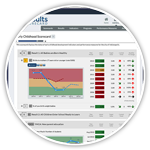Check out an updated version of this page here.
The Short Answer
1. Start with the common measures found in the upper right quadrant which apply to many programs.
2. Ask “What are the ways in which your customers would be better off if you did a good job.”
3. Examples of performance measures for selected programs are shown below.
Full Answer
(1) The intersection of quantity and quality vs. effort and effect accounts for all performance measures for all programs. Page 50 provides a summary of the types of performance measures found in each of the four quandrants formed by the intersection of these two dimensions.
There are common measures that apply to many programs, and then there are measures that are unique to a particular program or class of programs.
We will discuss the common measures first, and then provide specific measures for as many programs and services as we can.
1. Common measures (in the upper right quadrant):
 1. Client staff ratio
1. Client staff ratio
2. Staff turnover rate (This can be measured by % of vacant positions – or
more interestingly – % of employees with the organization 1 year or less.)
3. Staff morale (usually from surveys)
4. Percent of staff fully trained
5. Percent of satisfied customers (with service delivery functions)
6. Percent of customers seen in their own language
7. Worker safety (usually accident or injury claim rate)
2. Cost measures: The following measures are the standard cost measures which fall in each quadrant. The most difficult of these to obtain is the lower left “benefit value.” The cost benefit ratio equals the lower left over the upper left quadrant values.
How well we do it
Unit Cost
Percent growth in expenditure
|
Is anyone better off? – quality
Cost Benefit Ratio
Return on Investment
Percent Surplus/Deficit
|
What we do
Total Cost
|
Is anyone better off? – quantity
Benefit Value
Amount Surplus/Deficit
|
Program Specific Measures
The following section provides examples (not an exhaustive list) of some of the most important performance measures for each program or service. In most cases, the lay definition, but not the technical definition, is given.
3. Child Welfare
How well we do it
Caseload to worker ratio
% Foster children placed in their
original neighborhood / school
catchment area
Ave number of changed foster care
placements
% Investigations initiated within 24 hrs
% attending who apply for adoption
|
Is anyone better off? – quality
% Foster children in stable permanent
living arrangements after 6 months in
care.
% Repeat abuse/neglect cases
Rate of adoptions stable after 6 months
% of Foster Children with good school
attendance
% of Foster Children reading at grade level
|
What we do
# Foster Children served
# Child Abuse Investigations
# Adoption recruitment sessions
|
Is anyone better off? – quantity
#
#
#
#
#
|
Note: There are two powerful and important population indicators which are closely associated with child welfare: Rate of foster care and Rate of child abuse per 100,000 children. These should be treated in the same way as any other public health population indicator. The child welfare agency can take the lead in assembling and working with a broad partnership. But the agency is not solely responsible for these indicators, any more than the Health Department is responsible for the rate of HIV. In such situations, the agency should present its report on performance in two parts. Part one shows the population indicators, story behind the baselines, partners and what works strategy in the same way as any matter of population well-being. Part two shows the agency’s performance on the most important of the above performance measures.
4. Welfare to Work
How well we do it
% Participants with transportation and
child care needs met
% of Employers accepting placements
% Unit cost of each placement
|
Is anyone better off? – quality
% Participants who get and keep jobs 6 months, 12 months, 24 months
% of jobs at living wage
% of jobs with health and other benefits
% of children in placed families with
good school attendance.
|
What we do
# Job training sessions/trainees
# Employer contacts
# Employability plans developed
|
Is anyone better off? – quantity
#
#
#
#
|
Note: There are several powerful and important population indicators which are closely associated with child welfare: Poverty rate, Rate of entry onto welfare, and Percentage of families with a living wage. These should be treated in the same way as any other public health population indicator. The TANF / Welfare to Work agency can take the lead in assembling and working with a broad partnership. But the agency is not solely responsible for these indicators, any more than the Health Department is responsible for the rate of HIV. In such situations, the agency should present its report on performance in two parts. Part one shows the population indicators, story behind the baselines, partners and what works strategy in the same way as any matter of population well-being. Part two shows the agency’s performance on the most important of the above performance measures.
5. Education
How well we do it
Student – Teacher ratio
% faculty certified in the subject they
teach
% buildings without major maintenance
requirements
% parents involved in school
Average expenditure per student
Ave daily attendance reimbursement
as % of total possible
% non-traditional enrollment (voc ed)
|
Is anyone better off? – quality
% Reading scores at or above grade
% Math scores at or above grade
% with good attendance
% students in extra curricular activities
Graduation rate (% of 9th graders who
graduate on time 4 years later)
% graduates in school or jobs 1, 2, 5
years after graduation
% placement in jobs related to training (voc ed)
|
What we do
# students
# days of instruction
# parent teacher conferences
|
Is anyone better off? – quantity
#
#
#
#
#
#
|
6. Special Education – variations or additions to performance measures above
How well we do it
% Special Education students receiving
most of their education in regular
education classrooms
% IEP’s meeting time requirements
% parents involved in school
% receiving all required IEP services
|
Is anyone better off? – quality
% with improved reading scores from
last quarter
% with improved math scores from
last quarter
% Student and family satisfaction with
support and progress
Graduation rate (% of 9th graders who
graduate on time 4 years later)
% graduates in school or jobs 1, 2, 5
years after graduation
% Teen pregnancy or STD
|
What we do
# special education students by
type of disability
# IEP’s prepared / reviewed
# special education teachers
# parents/ teachers involved in IEP
development
|
Is anyone better off? – quantity
#
#
#
#
#
|
7. Juvenile Justice
How well we do it
% in community based vs. institutional
care
% intake screenings on time
Ratio of youth to probation officers
% of Juvenile Hall capacity occupied
|
Is anyone better off? – quality
Recidivism rate – % exiting custody with
no repeat offense in 6, 12, 24 months
Rate of probation violation
% youth in school or jobs
|
What we do
# Youth in custody
# Youth on probation
# Youth in Juvenile Hall
|
Is anyone better off? – quantity
#
#
#
|
Note: There are several powerful and important population indicators which are closely associated with juvenile justice, most important of these the juvenile crime rate and the violent crime rate. These should be treated in the same way as any other public health population indicator. The Juvenile Justice agency can take the lead in assembling and working with a broad partnership. But the agency is not solely responsible for these indicators, any more than the Health Department is responsible for the rate of HIV. In such situations, the agency should present its report on performance in two parts. Part one shows the population indicators, story behind the baselines, partners and what works strategy in the same way as any matter of population well-being. Part two shows the agency’s performance on the most important of the above performance measures.
8. Adult Corrections
How well we do it
Inmate/staff ratio
% positive drug screenings
Disruptive incidents per month
% inmates receiving drug treatment
% inmates receiving mental health svcs
|
Is anyone better off? – quality
Rate of escapes
Rate of recidivism
% inmates who get and keep jobs 6, 12
months after release
|
What we do
# adults in custody
# drug screening tests
|
Is anyone better off? – quantity
#
#
#
|
Note: There are several powerful and important population indicators which are closely associated with corrections, most important of these the crime rate and the violent crime rate. These should be treated in the same way as any other public health population indicator. The Corrections agency can take the lead in assembling and working with a broad partnership. But the agency is not solely responsible for these indicators, any more than the Health Department is responsible for the rate of HIV. In such situations, the agency should present its report on performance in two parts. Part one shows the population indicators, story behind the baselines, partners and what works strategy in the same way as any matter of population well-being. Part two shows the agency’s performance on the most important of the above performance measures.
9. Mental Health – Children and Youth
How well we do it
% intake and assessments
% occupancy
% bilingual staff
|
Is anyone better off? – quality
% youth who show improved CAFAS
scores from last quarter
% Youth in school or working
% Youth with attendance and grades
as good or better than last quarter
|
What we do
# clients (by diagnosis)
# beds
# outpatient clients
# hours of therapy
|
Is anyone better off? – quantity
#
#
#
|
Note: See note below Mental Health – Adults
10. Mental Health – Adults
How well we do it
% intake and assessments on time
% occupancy
Waiting list
Average hours of therapy per client
|
Is anyone better off? – quality
% clients who “recover” (defined as
lessening of diagnosis symptoms
below DSM definition)
% clients in school or working
% readmissions
|
What we do
# clients (by diagnosis)
# beds
# outpatient clients
# hours of therapy
|
Is anyone better off? – quantity
#
#
#
|
Note: There are several powerful and important population indicators which are closely associated with mental health, most important of these the prevalence of mental illness. These should be treated in the same way as any other public health population indicator. The Mental Health agency can take the lead in assembling and working with a broad partnership. But the agency is not solely responsible for these indicators, any more than the Health Department is responsible for the rate of HIV. In such situations, the agency should present its report on performance in two parts. Part one shows the population indicators, story behind the baselines, partners and what works strategy in the same way as any matter of population well-being. Part two shows the agency’s performance on the most important of the above performance measures.
11. Economic Development
How well we do it
Ranking on “business friendly”
environment
Average time from inquiry to response
% Business responses to contact
|
Is anyone better off? – quality
Rate of job growth from new businesses
Rate of living wage job growth
% of revenues paid by businesses
|
What we do
# Business contacts
#
#
|
Is anyone better off? – quantity
# new jobs from new businesses
#
#
|
Note: There are several powerful and important population indicators which are closely associated with economic development, including growth in gnp and unemployment rate. These should be treated in the same way as any other population indicator. The Economic Development agency can take the lead in assembling and working with a broad partnership to improve these numbers. But the agency is not solely responsible for these indicators, any more than the Health Department is responsible for the rate of HIV. In such situations, the agency should present its report on performance in two parts. Part one shows the population indicators, story behind the baselines, partners and what works strategy in the same way as any matter of population well-being. Part two shows the agency’s performance on the most important of the above performance measures.
 1. Client staff ratio
1. Client staff ratio


